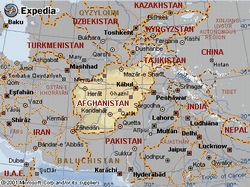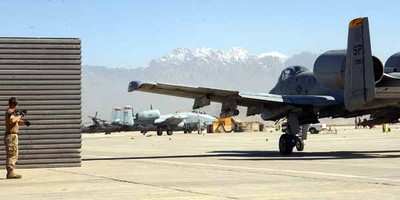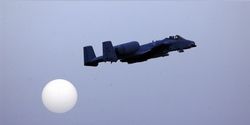'Round-The-Clock Effort Exceeds Commander's Expectations
 In Afghanistan, Air Force Reserve
and active-duty pilots have teamed together to protect US and
coalition forces from attackers whose aim is to disrupt national
stability and to prevent infrastructure improvements, including the
building of wells, schools and roads.
In Afghanistan, Air Force Reserve
and active-duty pilots have teamed together to protect US and
coalition forces from attackers whose aim is to disrupt national
stability and to prevent infrastructure improvements, including the
building of wells, schools and roads.
Fulfilling such missions requires 24-hour operations and live
munitions, but pilots and operations-support personnel from the
81st Expeditionary Fighter Squadron deployed at Bagram Air Base
north of Kabul say that's the only difference between serving at
Bagram Air Base and at their home stations.
"We train like we fight, so we're ready for contingencies like
this," said Air Force Capt. Travis, an 81st EFS pilot deployed from
Spangdahlem Air Base, Germany. Air Force officials omitted the last
names of pilots for security reasons.
Throughout the year, Spangdahlem pilots practice aerial tactics
and communications skills at NATO and joint-service exercises,
which prepare the active-duty airmen for sister-service and
coalition-force teamwork. Air Force reservists also practice in
such exercises and some serve as full-time reservists or pilots in
their civilian jobs, ensuring there is plenty of experience sitting
in the A-10 Thunderbolt II cockpits.
"The reservist and active-duty mix here has well exceeded my
expectations," said Air Force Lt. Col. John, 81st EFS commander.
"Once we all got here, we went straight to work. Here we support a
lot of customers at the table, working mostly with the Army,
escorting convoys and providing Afghan presidential escort, and
defending the troops as needed."
Working 24-hour ops means pulling 12-plus-hour shifts, leaving
little personal time. This can result in "Groundhog Day" syndrome
-- doing the same thing day in and day out -- which can wear on
morale, said Air Force Staff Sgt. Rebecca Nye, squadron operations
desk technician.
At Bagram, however, to stave off the feeling of
d�j� vu, pilots, "ops desk" technicians, maintainers
and ground troops make the time to visit each others' shops for
some face-to-face time with the people they're supporting.

"There's a lot of satisfaction in knowing we're helping the guys
on the ground," said Travis. "When we get together, we'll share our
side of the story, which helps us gain a perspective of what the
other guy sees and share lessons learned. This kind of face-to-face
interaction only helps us to get better."
Because the 81st EFS pilots have trained as they fight,
communicating with and providing cover for ground troops is the
pilots' No. 1 focus.
"We don't have to think about flying because it's second nature
to us," said Travis. "Our entire focus is on communicating with the
combat controller (who travels with the ground troops), who tells
us where our friendly forces are, the order of battle on the
ground, and where to employ our munitions."
 When pilots in Afghanistan pair up
to head out for a combat mission, the only factor taken into
consideration is experience, said Lt. Col. Ozzie, 81st EFS deputy
operations officer. Often it's a more experienced active-duty or
reserve pilot with another pilot who needs more time in the
aircraft to increase his qualifications.
When pilots in Afghanistan pair up
to head out for a combat mission, the only factor taken into
consideration is experience, said Lt. Col. Ozzie, 81st EFS deputy
operations officer. Often it's a more experienced active-duty or
reserve pilot with another pilot who needs more time in the
aircraft to increase his qualifications.
The teamwork involved in "keeping the A-10s in the air" helps
keep the energy high and mission accomplishment uppermost in the
minds of the airmen, said Col. John, 455th Expeditionary Operations
Group commander.
"I am extremely impressed with the way the two squadrons have
melded in both operations and maintenance," said the colonel. "It
is impossible to tell which unit a person is from unless you ask
them. They have come together here without working together prior
to the deployment and formed a single, lethal air power team.
"It's a validation of the great leadership and NCO cadre in both
the reserve and active component," he said.
(ANN salutes Staff Sgt. Jennifer Lindsey, 455th
Expeditionary Operations Group, USAF)
 ANN's Daily Aero-Term (12.19.25): Ultrahigh Frequency (UHF)
ANN's Daily Aero-Term (12.19.25): Ultrahigh Frequency (UHF) NTSB Prelim: Cirrus Design Corp SR22T
NTSB Prelim: Cirrus Design Corp SR22T Classic Aero-TV: The Red Tail Project--Carrying the Torch of the Tuskegee Airmen
Classic Aero-TV: The Red Tail Project--Carrying the Torch of the Tuskegee Airmen Aero-News: Quote of the Day (12.19.25)
Aero-News: Quote of the Day (12.19.25) Airborne 12.17.25: Skydiver Hooks Tail, Cooper Rotax Mount, NTSB v NDAA
Airborne 12.17.25: Skydiver Hooks Tail, Cooper Rotax Mount, NTSB v NDAA





